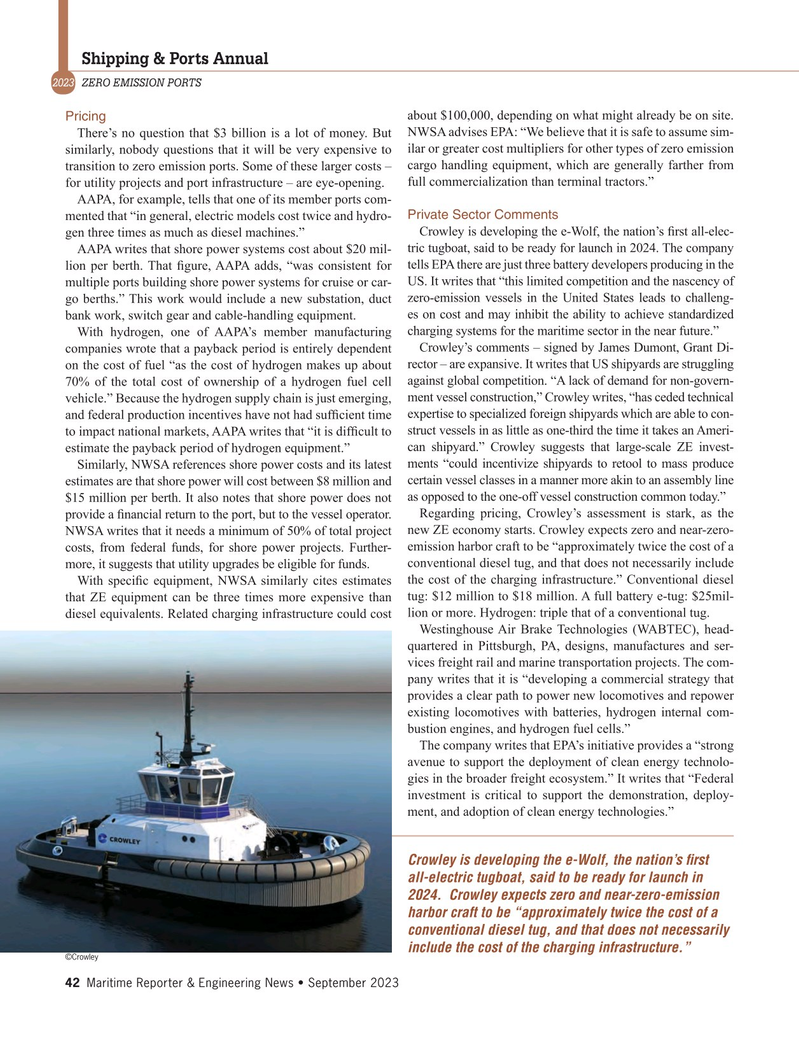
Page 42: of Maritime Reporter Magazine (September 2023)
Marine Design Edition
Read this page in Pdf, Flash or Html5 edition of September 2023 Maritime Reporter Magazine
Shipping & Ports Annual 2023 ZERO EMISSION PORTS
Pricing about $100,000, depending on what might already be on site.
There’s no question that $3 billion is a lot of money. But NWSA advises EPA: “We believe that it is safe to assume sim- similarly, nobody questions that it will be very expensive to ilar or greater cost multipliers for other types of zero emission transition to zero emission ports. Some of these larger costs – cargo handling equipment, which are generally farther from for utility projects and port infrastructure – are eye-opening. full commercialization than terminal tractors.”
AAPA, for example, tells that one of its member ports com- mented that “in general, electric models cost twice and hydro- Private Sector Comments gen three times as much as diesel machines.” Crowley is developing the e-Wolf, the nation’s ? rst all-elec-
AAPA writes that shore power systems cost about $20 mil- tric tugboat, said to be ready for launch in 2024. The company lion per berth. That ? gure, AAPA adds, “was consistent for tells EPA there are just three battery developers producing in the multiple ports building shore power systems for cruise or car- US. It writes that “this limited competition and the nascency of go berths.” This work would include a new substation, duct zero-emission vessels in the United States leads to challeng- bank work, switch gear and cable-handling equipment. es on cost and may inhibit the ability to achieve standardized
With hydrogen, one of AAPA’s member manufacturing charging systems for the maritime sector in the near future.” companies wrote that a payback period is entirely dependent Crowley’s comments – signed by James Dumont, Grant Di- on the cost of fuel “as the cost of hydrogen makes up about rector – are expansive. It writes that US shipyards are struggling 70% of the total cost of ownership of a hydrogen fuel cell against global competition. “A lack of demand for non-govern- vehicle.” Because the hydrogen supply chain is just emerging, ment vessel construction,” Crowley writes, “has ceded technical and federal production incentives have not had suf? cient time expertise to specialized foreign shipyards which are able to con- to impact national markets, AAPA writes that “it is dif? cult to struct vessels in as little as one-third the time it takes an Ameri- estimate the payback period of hydrogen equipment.” can shipyard.” Crowley suggests that large-scale ZE invest-
Similarly, NWSA references shore power costs and its latest ments “could incentivize shipyards to retool to mass produce estimates are that shore power will cost between $8 million and certain vessel classes in a manner more akin to an assembly line $15 million per berth. It also notes that shore power does not as opposed to the one-off vessel construction common today.” provide a ? nancial return to the port, but to the vessel operator. Regarding pricing, Crowley’s assessment is stark, as the
NWSA writes that it needs a minimum of 50% of total project new ZE economy starts. Crowley expects zero and near-zero- costs, from federal funds, for shore power projects. Further- emission harbor craft to be “approximately twice the cost of a more, it suggests that utility upgrades be eligible for funds. conventional diesel tug, and that does not necessarily include
With speci? c equipment, NWSA similarly cites estimates the cost of the charging infrastructure.” Conventional diesel that ZE equipment can be three times more expensive than tug: $12 million to $18 million. A full battery e-tug: $25mil- diesel equivalents. Related charging infrastructure could cost lion or more. Hydrogen: triple that of a conventional tug.
Westinghouse Air Brake Technologies (WABTEC), head- quartered in Pittsburgh, PA, designs, manufactures and ser- vices freight rail and marine transportation projects. The com- pany writes that it is “developing a commercial strategy that provides a clear path to power new locomotives and repower existing locomotives with batteries, hydrogen internal com- bustion engines, and hydrogen fuel cells.”
The company writes that EPA’s initiative provides a “strong avenue to support the deployment of clean energy technolo- gies in the broader freight ecosystem.” It writes that “Federal investment is critical to support the demonstration, deploy- ment, and adoption of clean energy technologies.”
Crowley is developing the e-Wolf, the nation’s ? rst all-electric tugboat, said to be ready for launch in 2024. Crowley expects zero and near-zero-emission harbor craft to be “approximately twice the cost of a conventional diesel tug, and that does not necessarily include the cost of the charging infrastructure.” ©Crowley 42 Maritime Reporter & Engineering News • September 2023
MR #9 (34-49).indd 42 9/6/2023 4:46:07 PM

 41
41

 43
43
